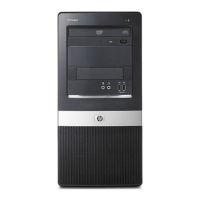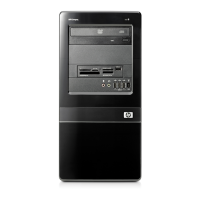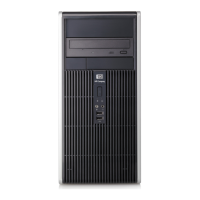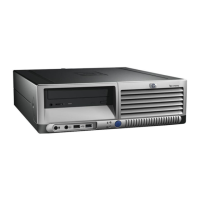
Do you have a question about the HP dx2310 - Microtower PC and is the answer not in the manual?
Details the automatic installation of Windows XP, Vista, or Redflag Linux upon first boot.
Instructions for installing device drivers after the operating system is installed.
Explains how Windows OS handles FAT32 to NTFS conversion for drives.
Information on obtaining and installing HP-specific software and drivers.
Details the diagnostic tests performed automatically when the system is turned on.
Explains how to access and use the F10 Computer Setup for system configuration.
Procedures for backing up and restoring computer CMOS settings using specific utilities.
Overview of HP computer preinstalled software images and deployment methods.
Information on BIOS storage, protection, and the FailSafe Boot Block ROM.
Configuration of the dual-state power button and system power management features.
Guidance on accessing HP's website for support software and drivers.
Details on user and supervisor passwords for system and setup access.
Description of the integrated surge-tolerant power supply's capabilities.
Technical specifications for SATA 3.0 hard drives, including pin counts and transfer rates.
Detailed pin assignments for SATA data and power cables.
Explanation of Self Monitoring Analysis and Recording Technology (SMART) for drives.
Information on maximum drive and partition sizes based on file system and OS.
Notes on SATA controller accessibility and modes in Windows environments.
Identifies the physical form factor of the computer chassis.
Guidelines for preventing damage to components from static electricity.
Instructions for safely cleaning the computer case, keyboard, monitor, and mouse.
Important notes on tools, screws, cables, connectors, and hard drive handling.
Steps to take before disassembling the computer, including power disconnection.
Instructions for removing the computer's side access panel and front bezel.
Guide on how to install DDR2 SDRAM memory modules into the system board sockets.
Procedures for installing and removing PCI/PCIe expansion cards.
Steps for locating, removing, and installing internal drives like hard drives.
Detailed instructions for removing and installing the computer's system board.
Steps for disconnecting and removing the computer's power supply unit.
Pin assignments for enhanced keyboard and mouse connectors.
Pin details for Ethernet RJ-45 and serial interfaces.
Pin configurations for USB ports and various audio connectors.
Pin assignments for monitor connections and power supply connectors.
Specifications for power cord length, approval, current capacity, and connector type.
Categorizes POST error messages by screen display and probable causes.
Troubleshooting steps for BIOS checksum, CMOS battery, and checksum errors.
Error messages related to CPU, keyboard, hard disk, and fans.
Interpreting power LED flashes and memory-related error codes.
Basic checks before diagnosing hardware or software issues.
Troubleshooting steps for common issues like power, display, audio, and peripherals.
Resolving issues with network cards, internet access, and connectivity.
Guidance for troubleshooting memory, processor, CD/DVD, and drive key issues.
Understanding front panel LED codes and audible beeps for diagnostics.
Details on supported DDR2 SDRAM DIMM types, speeds, and compatibility.












